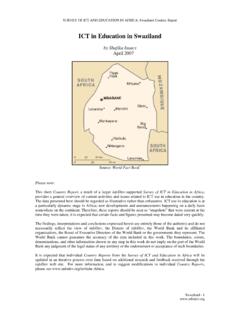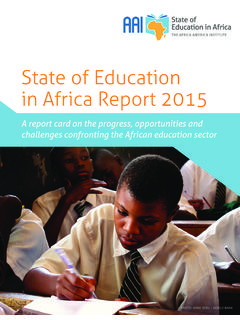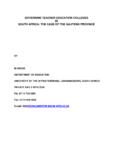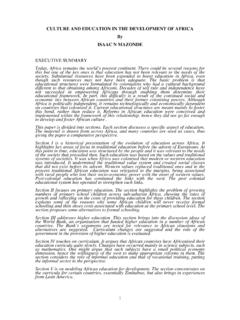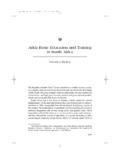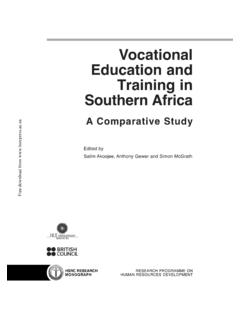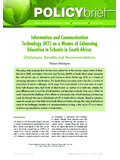Transcription of ICT in Education in Namibia
1 SURVEY OF ICT AND Education IN africa : Namibia Country Report ICT in Education in Namibia by Shafika Isaacs April 2007. Source: World Fact Book1. Please note: This short Country Report, a result of a larger infoDev-supported Survey of ICT in Education in africa , provides a general overview of current activities and issues related to ICT use in Education in the country. The data presented here should be regarded as illustrative rather than exhaustive. ICT use in Education is at a particularly dynamic stage in africa ; new developments and announcements happening on a daily basis somewhere on the continent. Therefore, these reports should be seen as snapshots that were current at the time they were taken; it is expected that certain facts and figures presented may become dated very quickly.
2 The findings, interpretations and conclusions expressed herein are entirely those of the author(s) and do not necessarily reflect the view of infoDev, the Donors of infoDev, the World Bank and its affiliated organizations, the Board of Executive Directors of the World Bank or the governments they represent. The World Bank cannot guarantee the accuracy of the data included in this work. The boundaries, colors, denominations, and other information shown on any map in this work do not imply on the part of the World Bank any judgment of the legal status of any territory or the endorsement or acceptance of such boundaries. It is expected that individual Country Reports from the Survey of ICT and Education in africa will be updated in an iterative process over time based on additional research and feedback received through the infoDev web site.
3 For more information, and to suggest modifications to individual Country Reports, please see Namibia - 1. SURVEY OF ICT AND Education IN africa : Namibia Country Report Overview Namibia has played a pioneering and visionary role in africa in the area of ICTs in Education and serves as a beacon for many organisations and groups operating across the continent. Namibia offers innovative options on affordable and sustainable access to ICTs through the active involvement of local youth under the leadership of SchoolNet Namibia . In addition to a visionary national ICT for Education policy, the Namibian government has also taken the lead in committing a dedicated budget to support ICTs in Education and the establishment of machinery for co-ordinated multi-stakeholder collaboration.
4 Country Profile Namibia is one of the world's most sparsely populated countries with a population of just over two million people living in an area slightly over half the size of Alaska which is 825,418 square kilometres. It has among the highest per capita income in sub-Saharan africa , but that income is unequally distributed. A 2000 survey of the Namibia labour force estimated the unemployment rate at 34% using the broad measure of unemployment nationwide. This high rate is partly attributed to exports of unprocessed primary products and the low levels of Education among the economically active population. Table 1 provides some selected socio-economic indicators for Namibia .
5 Table 1: Socio-economic Indicators: Namibia Indicator Population (2005) 2 million Languages Official language: English. Afrikaans is the common language of most of the population and about 60% of the white population. Other languages: German and indigenous languages (Oshivambo, Herero, Nama). Human Development Index 125 (out of 177 countries). Per capita Gross National $2,990 (2005). Income (US dollars). Namibia 's economy relies heavily on the extraction and processing of minerals as well as on processed fish for export. Namibia is the world's fifth-largest producer of uranium and a primary source of gem-quality diamonds. Cattle and sheep-raising dominate agriculture, and the country has one of the richest potential fisheries in the world.
6 Policies adopted since independence have been aimed at sustaining economic growth, diversifying the country's productive base, and attracting foreign investors. The Education System Namibia - 2. SURVEY OF ICT AND Education IN africa : Namibia Country Report Since gaining independence from South africa in 1990, Namibia 's Education system has undergone extraordinary transformation from servicing a privileged few to one involving all learners in integrated classrooms. Namibia 's school Education system begins with primary Education that lasts for seven years, divided into lower primary (four years) and upper primary (three years). Junior secondary Education lasts for three years and leads to the Namibian Junior Secondary Certificate.
7 Admission to senior secondary Education is based on the six best subjects in the Junior Secondary Certificate. Senior secondary Education lasts for two years and leads to the International General Certificate of Secondary Education (IGCSE) which gives access to higher Education . Vocational training centres (VTCs) offer technical subjects at the junior secondary level with options in bricklaying and plastering, electricity, motor mechanics, metalwork, welding, and woodwork. Higher Education is mainly provided by the University of Namibia , the Polytechnic of Namibia , colleges of Education , and colleges of agriculture. Namibia has about 19,000 teachers educating around 550,000 children in 1,550 schools.
8 There are seven VTCs, four colleges of Education , three agricultural training colleges, and one police training college. In addition, the Namibian College of Open Learning and private colleges like Damelin and the Higher Education Institute offer a variety of programmes in collaboration with other institutions. Table 2 provides a quantitative perspective of some selected system Table 2: Selected Education Data Indicator Enrolment in primary Education 101 (2004). (% gross)*. Enrolment in secondary 58 (2004). Education (% gross)*. Transition to secondary 88 (2003). Enrolment to tertiary Education 6 (2004). (% gross)*. Gender Parity Index (GPI)** in primary; in secondary; at university (2004).
9 Adult literacy male3 87% (2000-2004). Adult literacy female 83% (2000-2004). *Percent of gross is the number enrolled as a percentage of the number in the eligible age group. **GPI = gross enrolment ratio (GER) of females, divided by the GER of males and indicates the level of access by females to Education compared to males. Namibia demonstrates gender parity at primary secondary and university levels. A recent World Bank report on Namibia 's Education found that it was not meeting the needs of the country's economy and was ineffective. It also found that Namibia 's lack of early childhood development resulted in 80% of children entering Grade 1 without the Namibia - 3.
10 SURVEY OF ICT AND Education IN africa : Namibia Country Report required level of learning readiness, while 60% of primary school teachers and 30% of secondary school teachers were unqualified. Of those teachers who are qualified, a large proportion lack essential competencies, such as mastery of their teaching subjects, good English proficiency, reading skills, curriculum interpretation, and setting student The World Bank study also found that curricula were overloaded with too many subjects that lacked clear standards, there was a shortage of schoolbooks, and 21% of all schools had no permanent classrooms. As well, just a third of children enrolled in Grade 1.
